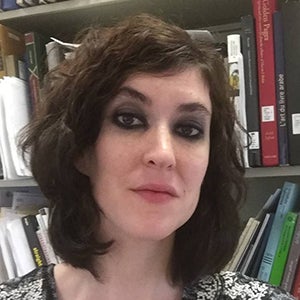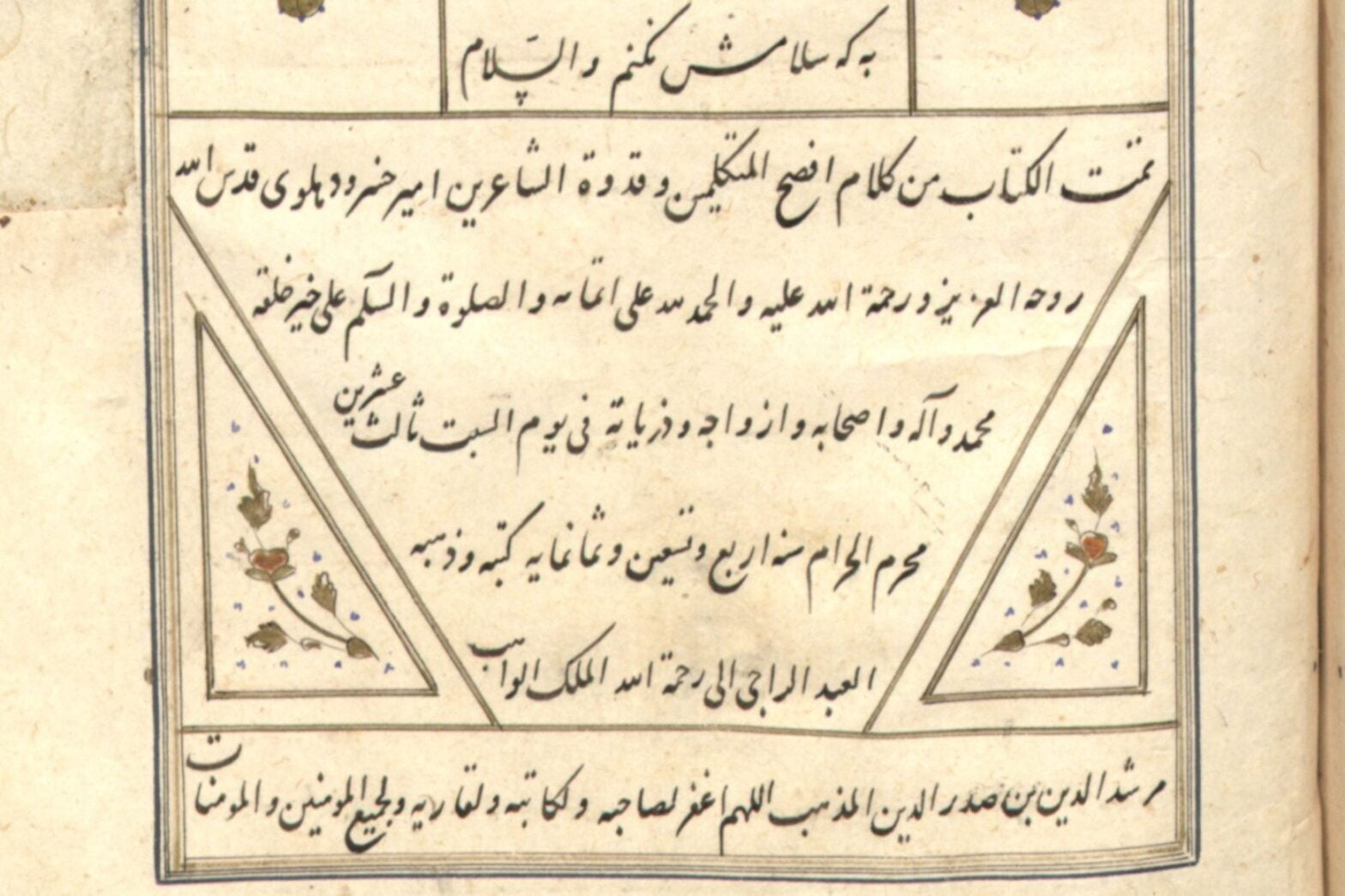Colophon
Evyn Kropf
Related Terms:
- Frontispiece (title page)
- Khatt (calligraphy)
- Kitabkhana (workshop–library)
- Muraqqa‘ (album or patchwork)
- Qalam (pen used for calligraphy)
- Qur’an (the sacred text of Islam)
- Tadhhib (illumination)
- Waqf / Waqfiyya (endowment)
Related Khamseen Videos:
Sabiha Göloğlu, “Touching Mecca & Medina: The Dalā’il al-Khayrāt and Devotional Practices,” Khamseen: Islamic Art History Online, published 28 August 2020.
Marika Sardar, “The Gwalior Qur’an,” Khamseen: Islamic Art History Online, published 28 August 2020.
Ayşin Yoltar-Yıldırım, “The Birth Scene of Iskandar (Alexander the Great),” Khamseen: Islamic Art History Online, published 9 February 2021.
References:
“Colophon.” In Adam Gacek, Arabic Manuscripts: A Vademecum for Readers (Leiden: Brill, 2009): 71–76. ![]()
“Colophon.” In The Grove Encyclopedia of Islamic Art and Architecture, edited by Jonathan M. Bloom and Sheila S. Blair (Oxford: Oxford University Press, 2009). Consulted online. ![]()
“Colophons and dates.” In François Déroche, et al, Islamic Codicology: An Introduction to the Study of Manuscripts in Arabic Script (London: Al-Furqān Islamic Heritage Foundation, 2006): 318–330. ![]()
Bahl, Christopher D. and Stefan Hanß, eds. Scribal Practice and the Global Culture of Colophons, 1400-1800. Cham: Palgrave Macmillan, 2022. ![]()
Bilgin, Orhan. “Ferâğ kaydı.” TDV İslâm Ansiklopedisi, Consulted online (open access). ![]()
Binabīn, Aḥmad Shawqī and Muṣṭafá Ṭūbī. “al-Takhtīm aw al-takhtīmah”, “taqyīd al-khitām”, “ḥard al-matn”, “qayd shud”, “qayd al-farāgh.” In Muʻjam muṣṭalaḥāt al-makhṭūṭ al-ʻArabī: Qāmūs kūdīkūlūjī (al-Ribāṭ: al-Khizānah al-Ḥasanīyah, 2004): 63, 83, 112, 245. ![]()
Poonawala, Ismail K. “The Contribution of Ismāʿīlī Colophons to the Discussion on the Birth and Construction of the Arabic Manuscript Tradition.” Chroniques du manuscrit au yémen 27, 8 (Janvier 2018): 74–139. Consulted online (open access). ![]()
Quiring-Zoche, Rosemarie. “The Colophon in Arabic Manuscripts. A Phenomenon Without a Name.” Journal of Islamic Manuscripts 4 (2013): 49–81. ![]()
al-Sāmarrāʾī, Qāsim. “Taqyīd al-khitām.” ʻIlm al-iktināh al-ʻArabī al-Islāmī (al-Riyāḍ: Markaz al-Malik Fayṣal lil-Buḥūth wa-al-Dirāsāt al-Islāmīyah, 2001): 171–173. ![]()
Ṣafarī Āqʹqalʻah, ʻAlī. “Anjāmah-yi nuskhah.” Nuskhahʹshinākht: pizhūhishnāmah-ʼi nuskhahʹshināsī-i nusakh-i khaṭṭī-i Fārsī (Tihrān: Markaz-i Pizhūhishī-i Mīrās̲-i Maktūb, 2011): 323-317. ![]()
Sirinian, Anna. “On the Historical and Literary Value of the Colophons in Armenian Manuscripts.” In Armenian Philology in the Modern Era: From Manuscript to Digital Text, edited by Valentina Calzolari (Leiden: Brill, 2014): 65–100. ![]()
Şeşen, Ramazan. “Esquisse d’une histoire du développement des colophons dans les manuscrits musulmans.” In Scribes et manuscrits du Moyen-Orient, edited by François Déroche and Francis Richard (Paris: Bibliothèque nationale de France, 1997): 189–221. ![]()
Citation:
Evyn Kropf, “Colophon,” Khamseen: Islamic Art History Online, published 13 September 2022.

Evyn Kropf is a librarian and curator of Islamic manuscripts at the University of Michigan Library. As a specialist of Islamic codicology and Arabic manuscript culture, her particular interests include writing material (especially paper), structural repairs, reading and collecting practices of the Ottoman era as well as the significance of pictograms and other visual content for Sufi knowledge transmission. Her recent publications include, among others, “Recalling Alikurna: “ليكوريا” Countermarked Paper among Scribes in the Late 19th Century Ottoman Levant,” In The Trade in Papers Marked with Non-Latin Characters (Brill, 2018) and “‘Sensible Metaphors’: Pictograms in the Transmission of ʿAbd al-Wahhāb al-Shaʽrānī’s (d.973/1565) al-Mīzān al-kubrá,” In Visualizing Sufism (Brill, 2022).


